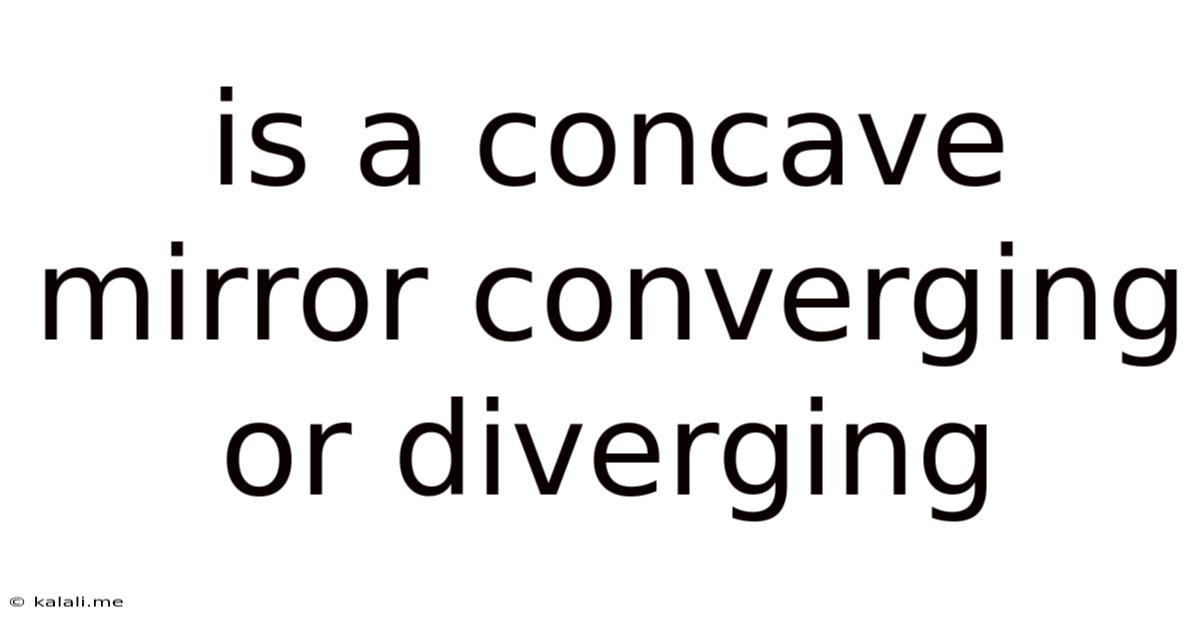Is A Concave Mirror Converging Or Diverging
Kalali
Jun 11, 2025 · 3 min read

Table of Contents
Is a Concave Mirror Converging or Diverging? Understanding Mirror Types and Their Properties
A common question in optics is whether a concave mirror is converging or diverging. The answer is simple: a concave mirror is a converging mirror. This article will delve deeper into understanding why, explaining the key differences between concave and convex mirrors and how their shapes affect light reflection. Understanding this fundamental concept is crucial for anyone studying optics, from high school students to advanced physics enthusiasts.
Understanding Concave Mirrors: The Basics
A concave mirror is a type of curved mirror where the reflective surface curves inwards, like the inside of a spoon. This inward curve is what dictates its converging properties. When parallel rays of light strike a concave mirror, they reflect and converge at a single point called the focal point (or focus). The distance between the mirror's surface and the focal point is called the focal length.
Why Concave Mirrors Converge Light
The converging nature of a concave mirror stems directly from the law of reflection. This law states that the angle of incidence (the angle between the incoming ray and the normal to the surface) is equal to the angle of reflection (the angle between the reflected ray and the normal). Because the surface of a concave mirror curves inward, the normals at different points on the mirror's surface point towards the center of curvature. This geometric arrangement ensures that parallel incident rays are reflected towards the focal point.
Contrasting Concave and Convex Mirrors
To fully grasp the concept, let's contrast concave mirrors with their counterparts: convex mirrors. Convex mirrors have a reflective surface that curves outwards, like the outside of a spoon. Unlike concave mirrors, convex mirrors are diverging mirrors. Parallel rays of light striking a convex mirror reflect in such a way that they appear to diverge from a virtual focal point behind the mirror. This means they do not actually converge to a single point.
Applications of Converging Concave Mirrors
The converging property of concave mirrors makes them incredibly useful in various applications, including:
- Telescopes: Large concave mirrors are used in reflecting telescopes to gather and focus light from distant stars and galaxies.
- Flashlights and Headlamps: Concave reflectors are used to focus the light emitted from a bulb, creating a concentrated and directed beam.
- Solar Furnaces: Large concave mirrors can be used to concentrate sunlight onto a small area, generating extremely high temperatures.
- Medical Imaging: Some medical instruments utilize concave mirrors for precise imaging.
Key Differences Summarized
| Feature | Concave Mirror | Convex Mirror |
|---|---|---|
| Shape | Curves inwards | Curves outwards |
| Light Behavior | Converges light | Diverges light |
| Focal Point | Real (light rays actually meet) | Virtual (light rays appear to diverge from) |
| Image Formation | Can produce real and virtual images | Only produces virtual images |
In conclusion, the concave mirror's inward curvature dictates its converging nature. This fundamental property leads to its widespread use in a variety of optical applications, contrasting sharply with the diverging behavior of convex mirrors. Understanding this distinction is key to comprehending the principles of geometric optics and their practical applications.
Latest Posts
Latest Posts
-
How Do You Say Grandparents In Spanish
Jul 02, 2025
-
How Many Numbers Are Between 48 To 24
Jul 02, 2025
-
How Many Positions Are There In Sex
Jul 02, 2025
-
How Many Minutes Are In 10 Miles
Jul 02, 2025
-
How Many Milliseconds Are In A Day
Jul 02, 2025
Related Post
Thank you for visiting our website which covers about Is A Concave Mirror Converging Or Diverging . We hope the information provided has been useful to you. Feel free to contact us if you have any questions or need further assistance. See you next time and don't miss to bookmark.